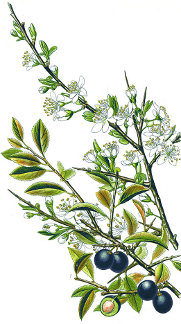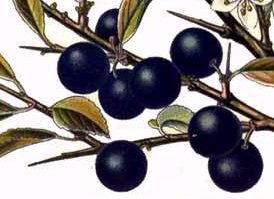 Prunus
spinosa Prunus
spinosaBlackthorn This plant naturally will spread outward in a circle, the inner part gradually dying with new plants form on the edges. Such thickets were thought to act as borders around Faery Mounds. You can see blackthorn's Saturn aspect there both in terms of the plant as a border guardian and in its connection with the underneath or the hidden--literally, the occult. The very ferocious thorns of this tree have been used in assault magic to impale poppets, but in the Balkans, blackthorn stakes were used to impale vampires. Saturnian plants are good for curse magic but also can be quite helpful in connecting to the aspect of Saturn that guards underground treasures, be they of metallic ore or of seed. Blackthorn tends to bloom before it leafs out, during the first warm spell of early spring, which time is generally followed by another cold spell known as Blackthorn Winter, which can mean that the summer will not be a very fruitful one. Likewise, if blackthorn produces a lot of sloes (the fruits), this is an indicator of a hard winter to follow. The flowers are pretty but are not to be worn or brought in the house, as they are considered tokens of death. For all blackthorn's hazardousness, it was thought that if a whitethorn were grown near it, the whitethorn would destroy it. Particular holy days for blackthorn, when it must not be cut according to Irish folklore, are November 11 (Samhain old style) and May 11 (Beltane old style). Also, typically people did not harvest sloes after Halloween, since the Fae blighted them then.  The witch's blasting rod, an instrument for cursing
and especially for causing miscarriages (shudder), was made from
blackthorn, although of course it is also a common choice for an
ordinary walking stick. For all its bad reputation, in the Slavic
world, bits of blackthorn were sewn into clothing for protection. There
seems also to be a tradition in various places in England of burning or
calcining blackthorn and then sprinkling the ashes over a grain field
to ensure fertility, perhaps on account of the many sloes the plant
produces (so magic by likeness) but perhaps also for its protective
properties, ensuring the grain would not be blighted by the curses of
jealous neighbors. The berries will make a slate-blue dye without a
mordant and a sturdy ink. Thorns are extremely sharp and an untended
wound from one can easily become infected; remember that puncture
wounds are the worst that way, so be careful. Top The witch's blasting rod, an instrument for cursing
and especially for causing miscarriages (shudder), was made from
blackthorn, although of course it is also a common choice for an
ordinary walking stick. For all its bad reputation, in the Slavic
world, bits of blackthorn were sewn into clothing for protection. There
seems also to be a tradition in various places in England of burning or
calcining blackthorn and then sprinkling the ashes over a grain field
to ensure fertility, perhaps on account of the many sloes the plant
produces (so magic by likeness) but perhaps also for its protective
properties, ensuring the grain would not be blighted by the curses of
jealous neighbors. The berries will make a slate-blue dye without a
mordant and a sturdy ink. Thorns are extremely sharp and an untended
wound from one can easily become infected; remember that puncture
wounds are the worst that way, so be careful. Top
How to Grow Blackthorn This seed is tough to germinate. The best time to start is October/November. The method is complicated because blackthorn seeds are naturally deeply dormant. Soak the seeds in cold water in the coldest part of your fridge for 48 hours, changing the water once. Then drain and plant in a small pot, cell-pack, or seed tray filled with a mixture of 1/2 peat moss and 1/2 sand or other quickly draining stuff (like vermiculite or perlite). Put the pot or seedtray in a plastic bag. Fold the top closed or tie it very loosely. You want air to be able to get in and out. Put outside in the fall on the north side of the house or a protected place with full shade (NO sun). Seeds should start to germinate in the spring, but blackthorn can take two winters to germinate. When they germinate, put them in a deep pot (trees get long roots fast) or in the ground in a well worked bed. You can try duplicating this using instead a refrigerator. In that case, the required temperatures for germination are 2-4 weeks warm (60F/15°C) then 16-24 weeks cold (40F/4°C). Seeds will stay alive for a number of years if stored cool and dry. Transplant to open spots in woodland or hedgerows, partial shade to sun; it will fruit better with more sun. It can grow in any kind of soil and is hardy to zone 4. It has become naturalized in the Northwest, Midatlantic, New England, and Ontario, which gives a good idea of where it likes to grow. It does not like a hot climate. This small tree/large shrub gets 9ft/3m tall amd provides good protection for birds; bees like the flowers, which appear in early spring, and various moth and butterfly caterpillars like to eat the leaves. Harvest berries after frost for best flavor. Seeds in fruit are ripe in late fall. General growing info. Top |
Prunus
spinosa
Uses in Witchcraft & Magic: Protection of
borders ©
2013-2025 Alchemy Works; No reproduction without permission
|